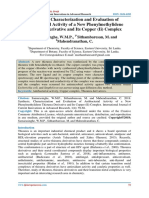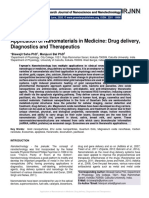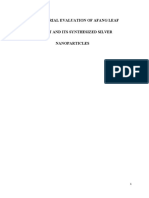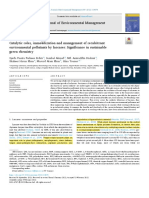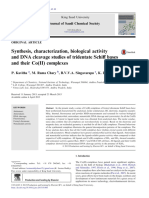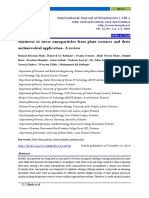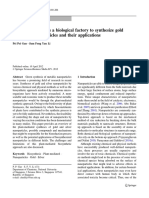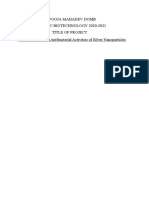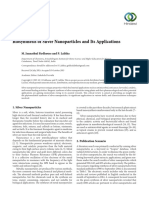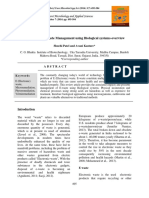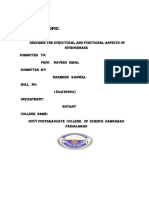Professional Documents
Culture Documents
Synthesis, Characterization and Antimicrobial Properties of Mixed Ligand of Sulphamethoxazole and Trimethoprim and Their Manganese (II) and Copper (II) Complexes
Copyright
Available Formats
Share this document
Did you find this document useful?
Is this content inappropriate?
Report this DocumentCopyright:
Available Formats
Synthesis, Characterization and Antimicrobial Properties of Mixed Ligand of Sulphamethoxazole and Trimethoprim and Their Manganese (II) and Copper (II) Complexes
Copyright:
Available Formats
Volume 7, Issue 2, February – 2022 International Journal of Innovative Science and Research Technology
ISSN No:-2456-2165
Synthesis, Characterization and Antimicrobial
Properties of Mixed Ligand of Sulphamethoxazole
and Trimethoprim and Their Manganese (II) and
Copper (II) Complexes
Olagboye S.A. And Ige S.E.
Chemistry Department, Ekiti State University, Ado- Ekiti.
Abstract:- Sulphamethoxazole and trimethoprim mixed health defects such as cardiovascular, nervous, kidney and
ligand and their Mn(II) and Cu(II) metal complexes have bone diseases (Araromi et al., 2020). Copper is an example
been synthesized and characterized. The characterization of transition metal, it plays a crucial role in human
of metal complexes is based on the results of the solubility, metabolism because it allows many critical enzymes to
colour, melting points and spectroscopic studies. The UV- function properly. Copper is essential for maintaining the
Visible spectra revealed characteristic wavelength strength of the skin, blood vessels, epithelial and connective
maxima at 600 nm, 700 nm, 750 nm and 800 nm assigned tissues throughout the body. It is highly important in the
to the d-d electronic transition of the metal complexes. production of hemoglobin, myelin, melanin and it also keeps
The FTIR results confirmed that the manganese and thyroid gland functioning normally. Copper can act as both
copper ions coordinated through the nitrogen atom and an antioxidant and a pro-oxidant (Osredkar & Sustar, 2011).
oxygen atom (S=O) of sulphamethoxazole and through
the nitrogen atoms in trimethoprim. The antimicrobial Cu(II) Complexes are four-coordinate which are
activities of the metal complexes synthesized indicated generally blue or green due to the maximum of four electronic
that the metal complexes were more potent against transitions; d-d transitions; charge transfer transitions and
selected organisms than the free ligands. internal ligand transitions. Electronic spectroscopy cannot be
used in isolation as a tool for structural identification due to
Keywords:- Sulphamethoxazole, Trimethoprim, Mixed the large distortion associated with this compound (Gaikwad
ligands, Metal complexes, Antimicrobial activities, Spectra & Yadav, 2016). Cu is one of the various metals commonly
studies, Characterization. used for metal based drugs because of its ability to form low
molecular weight complexes which prove to be more potent
I. INTRODUCTION against several diseases (Olagboye et al., 2018; Kozarich,
2005). Whereas, manganese is a hard but brittle metal which
The discovery of coordination compounds resulted in a is difficult to fuse but easy to oxidize. Manganese have
synthetic revolution in Inorganic Chemistry which leads to variable oxidation state from +2 to +7 but the +2 state is most
formation of new products with effective applications in wide prevalent in the biological system. Manganese (II) ions
selection of areas including fungicides, paints, pigments, function as cofactors for a large variety of enzymes with
polymers, pharmaceuticals, catalysis and photoconductors many functions (Schmidt and Husted, 2019).
(Gaikwad & Yadav, 2016). The effectiveness of a
coordination compound can be enhanced by the nature of Metal complexes formed from most transition metal
ligands coordinated. The nature of metal- ligand bonding ions is an important class of coordination compounds which
range from covalent to ionic with bond order from one to are studied extensively due to their enormous applicability in
three. Ligands are lewis bases but in rare cases occur as lewis various fields of human interests (Ejelonu et al., 2018)
acids. ranging from biological, chemical, agricultural and industrial
applications. Metal drug complexes are attracting research
Transition metals are a class of element with partially interests due to their increasing importance in the design of
filled d sub-shell distinguished by characteristics such as drugs (Lawal and Obaleye, 2007).
formation of coloured compounds, having variable oxidation
state and formation of complexes. Although, high level of Antioxidant, water softening, ion exchange resin,
heavy metals could relatively lead to increase serum liver photosynthesis in plants, removal of undesirable and harmful
enzymes, kidney function parameters and reduction in metals from living organisms, electroplating and dying are
haemoglobin level packed cell volume and Red Blood Cells some of the diverse ways in which mixed ligand complexes
(Oguntuase et al., 2019), Cu and Mn are nutrient minerals are applied in medicine, chemical and biological systems
which play major roles in metabolic processes such as (Taghreeed & Lekaa, 2016).
muscular activity, endocrine function, reproduction, skeletal
integrity and overall development (Adeyeye et al., 2021). Microbial infections are a menace worldwide which
They are essential micronutrients for plants and animals does not subside despite active research devoted to the
growth but when present in higher concentrations can cause discovery and development of novel antimicrobial agents.
IJISRT22FEB469 www.ijisrt.com 716
Volume 7, Issue 2, February – 2022 International Journal of Innovative Science and Research Technology
ISSN No:-2456-2165
Antibiotics are used to treat bacterial infections and its A. Physical measurement
improper and unnecessary use has made antibiotic resistance The melting points of the complexes were determined
a growing problem (Miniyar & Makhija, 2009). using melting point apparatus. The solubility tests were
carried using polar and non polar solvents. The FTIR spectra
Sulphamethoxazole is an antibacterial which has been were recorded using FTIR 8300 shimadzu
utilized in combination with trimethoprim or pyrimethamine specterophotometer in the frequency range of 4000-400cm-1.
since the 1960s for the treatment of various systemic The UV-visible spectra were also recorded using shimadzu
infections in humans and other species (IARC monographs UV-VIS.16OA ultra-violet spectrophotometer in the range of
Vol. 79). Urinary tract infection is one of the most common 200-800nm.
infectious diseases caused by Escherichia coli in many
countries. E. coli have been found to be highly resistant to III. EXPERIMENTAL
trimethoprim-sulphamethoxazole (Kurutepe et al., 2005),
efforts are therefore progressively made to develop novel A. Synthesis of Sulphamethoxazole-metal complexes in
antibiotics. ratios 1:1 and 1:2
The complexes were prepared by adding aqueous
Trimethoprim (TMP) is an antibiotic drug used mainly methanol solution of 0.01mol of the cu (1.7054g) & Mn
in the treatment of bladder infections, it is also used for (1.69g) metal salts to an aqueous methanol solution of 0.01
middle ear infections and travellers’diarrhoea. It interferes (2.5328g) and 0.02 (5.0656g) moles sulphamethoxazole
with the production of tetrahydrofolic acid, a chemical that is respectively. The mixture was stirred for 2hrs 30mins on a
necessary so as for bacteria and human cells to produce magnetic stirrer. The complexes were recovered from
proteins (Akinyele et al., 2020). The pharmaceutical use of solutions by filtration followed by washing with distilled
metal complexes has excellent potentials (Zhang & Lippard, water and methanol and then dried to a constant weight in a
2003) which has gained tremendous attention overtime dessicator.
(Ejelonu et al., 2018; Allardyce et al., 2005).
B. Synthesis of the mixed ligand-metal complexes
Malaria, tuberculosis and AIDS are the three major 2.5328g (0.01mole) of sulphamethoxazole and
infectious diseases grievously damaging the world. Efforts 2.9032g(0.01mole) of trimethoprim were dissolved in 20ml
are being made to eradicate and control malaria for over a aqueous methanol. 0.01mole (1.69g MnSO4.H2O and
decade but the disease still remain a major threat to human 1.7054g CuCl2.2H2O) of the metal salts were added. The
health and economic development around the world. resulting solution was stirred for 2hrs 30mins on a magnetic
Sulfanilamides are used as antibacterial as well as stirrer. The product formed was filtered, washed with a
antimalarial drugs (Ajibade et al., 2006). The continuous mixture of methanol and water and then dried to a constant
emergence of resistant parasites to available antimalarial weight in a dessicator.
drugs has made the development of novel antimalarials and
modification of existing antimalarial drugs a necessity in C. Antimicrobial studies of the metal complexes
order to eradicate or control the disease. This research work Ten (10) different bacteria and four fungi were collected
involved the synthesis, characterization and antimicrobial from University of ife Teaching Hospital, Ile ife osun state
properties of sulphamethoxazole and trimethoprim mixed Nigeria. They were sub-cultured on nutrient agar for bacteria
ligand metal complexes. and potato dextrose agar for fungi. Both media were prepared
according to manufacturer’s specifications. True
II. MATERIALS AND METHODS representatives of each of the different organisms were sub-
cultured, their identification and taxonomic studies were
Materials and Reagents; Trimethoprim Salt, carried out to confirm each organism. The confirmed
Sulphamethoxazole Salt, Manganese(II)sulphate organisms were then prepared for use as test organisms for
monohydrate (MnSO4.H2O), Copper(II)Chloride dihydrate the antibiotic susceptibility test. Each of the test organisms
(CuCl2.2H2O), Methanol, sodium hydroxide, hydrogen was transferred to a liquid medium nutrient both for bacteria
peroxide, n-Hexane, chloroform and ethanol used were and enriched peptone both for fungi. They were inoculated
obtained in analytical grade and used without further for 18h after which they were used for the test. Mueller-
purification. Hinton agar was prepared according to manufacturer’s
specification, poured into petri dishes and allowed to set.
Sterile swab were then used to seed the set agar plates with
each test organism, then an 8mm diameter cork-borer was
used to bore wells in the plates, after which each wells was
filled with the solution of each test compound. The plates
were incubated for 24h at 370c.
IJISRT22FEB469 www.ijisrt.com 717
Volume 7, Issue 2, February – 2022 International Journal of Innovative Science and Research Technology
ISSN No:-2456-2165
IV. RESULTS AND DISCUSSIONS
TABLE 1; PHYSICAL AND ANALYTICAL DATA OF THE COMPLEXES
COMPLEXES MOLECULAR WEIGTH COLOUR YIELD (%) MELTING POINT (°C)
SMT C10H11N3O3S 253.28 White - 165-167
TMP C14H18N4O3 290.32 White - 190-192
[Cu(SMT)Cl2]H2O 405.55 Green 51 148-150
[Cu(SMT)2Cl2]H2O 658.55 Light green 53 152-154
[Cu(SMT-TMP)Cl2]H2O 695.55 Light green 65 138-140
Mn(SMT)SO4 403.94 White 48 166-168
Mn(SMT)2SO4 656.94 White 75 166-168
Mn(SMT-TMP)SO4 693.94 693.94 90 172-174
LEGEND; SMT= SULPHAMETHOXAZOLE (C10H11N3O3S) TMP= TRIMETHOPRIM (C14H18N4O3)
The results of the physical measurements are presented which could be linked to the reactivity of the metals. Sharp
in Table 1. All the complexes were stable and obtained in melting points were observed in all the complexes with
moderate to high yield 48% - 90%. The mixed ligand- melting temperature ranging from 138°C in copper mixed
manganese complex has the highest yield of 90% while the ligand complex to 174°C in manganese mixed ligand
least yield was recorded from the 1:1 sulphamethoxazole- complex suggesting the formation of pure metal complexes.
manganese complex. The copper complexes generally have The melting point is generally higher in the manganese
less yield compared to their analogous manganese complexes complexes than their corresponding copper complexes.
TABLE 2; SOLUBILITY OF THE COMPLEXES
COMPLEXES Chloroform Ethanol n-Hexane Ethyl acetate
[Cu(SMT)Cl2]H2O Very soluble Very soluble Slightly soluble Very soluble
[Cu(SMT)2Cl2]H2O Very soluble Very soluble Slightly soluble Very soluble
[Cu(SMT-TMP)Cl2]H2O Very soluble Very soluble Slightly soluble Very soluble
Mn(SMT)SO4 Very soluble Very soluble Slightly soluble Very soluble
Mn(SMT)2SO4 Very soluble Very soluble Slightly soluble Very soluble
Mn(SMT-TMP)SO4 Very soluble Very soluble Slightly soluble Very soluble
The solubility test of the complexes were also done strongly affected by the presence of other species such as
using different solvents, they were soluble in chloroform, anions and ligands, therefore, the colour of the metal complex
ethyl acetate and ethanol but insoluble in n-hexane. solution changes as well as the wavelength of maximum
absorption. The wavelength of maximum absorption was
The result of the UV-visible analysis of the compounds observed at 700 nm for the metal complexes. Higher
prepared is presented in Table 3. The results indicated that the absorbances (23.86, 23.54 and 23.67) were observed for the
metal complexes are coloured because of the d-d electronic Copper (II) complexes as compared to the manganese (II)
transition within the metal atoms and charge transfer between complexes (23.06, 23.56 and 23.75).
the metal and the ligands. The colour of metal ion solution is
TABLE 3: UV RESULT OF THE COMPLEXES
Wavelengths (nm) 200 300 400 500 600 700 800 900
SMT 0.09 0.09 0.59 10.10 17.75 23.24 13.16 13.99
[Cu(SMT)Cl2]H2O 0.09 0.10 0.57 10.08 17.89 23.86 13.12 13.95
[Cu(SMT)2Cl2]H2O 0.09 0.10 0.59 10.07 17.75 23.54 13.11 13.93
[Cu(SMT-TMP)Cl2]H2O 0.09 0.10 0.57 10.13 17.83 23.67 13.98 14.02
Mn(SMT)SO4 0.09 0.10 0.57 10.07 17.75 23.06 13.11 13.94
Mn(SMT)2SO4 0.09 0.10 0.58 10.26 18.02 23.56 13.79 14.18
Mn(SMT-TMP)SO4 0.09 0.10 0.59 10.16 17.92 23.75 13.59 14.07
The prominent IR bands of the ligands and metal far IR region (400 - 600cm-1) while the bands due to structural
complexes are represented with table 4. The stretching modes changes of the ligands appear in the finger print region of the
of the ligands are expected to change upon complexation due spectra (1500-750cm-1) (Saha et al., 2002; Nakamoto, 1986).
to either weakening or strengthening of the bonds involved in Assignments of bands are done based on comparison with the
the bond formation (Olagboye et al., 2018) the absorption spectra data of similar compounds (Lawal and Obaleye,
bands due to metal- ligand coordination are observed in the 2007). The bonding of the ligands to metal ions was
IJISRT22FEB469 www.ijisrt.com 718
Volume 7, Issue 2, February – 2022 International Journal of Innovative Science and Research Technology
ISSN No:-2456-2165
investigated by comparing the FTIR spectra of the complexes through the N atom of sulfonamide group and one of the
with those of the free ligands (Eugene-Osoikhia et al., 2020). oxygen atom of the sulfonyl. The absence of broad bands in
the region 3300-3500 in all the spectra of the complexes
IR spectrum of the free ligand shows two strong bands indicates that there is no coordinated H2O molecule. The
at 3465 and 3374 cm-1 equivalent to the asymmetric and metal-nitrogen and metal-oxygen stretching frequency were
symmetric stretching vibrations of the aromatic amino group observed at 682-685 and 559-562 cm-1 respectively for all the
(NH2). This band did not show any appreciable changes in all metal complexes.
the complexes which demonstrates its non participation in the
coordination (Eugene-Osoikhia et al., 2020 ; Rostamizadeh Generally, mixed ligand complexes demonstrate better
et al., 2019). The medium and strong signals at 3140 and activities because chelation reduces the polarity of the metal
3296 cm-1 are due to the presence of asymmetric and ion by partial sharing of its positive charge with the donor
symmetric frequency vibration of the sulfonamide -NH groups and also due to pi -electron delocalization on the
group. The shifting of the band in the spectra of the whole chelating ring, increased lipophilicity enhances the
complexes indicated its involvement in the coordination or penetration of the complexes into lipid membrane and
chelation with central metal ion through the N atom of this blocking off all of the metal binding sites in the enzymes of
group (Eugene-Osoikhia et al., 2020 ; Mondelli et al., 2013). microorganisms. These complexes also disturb the
The peak at 1613 is assigned to the C=N stretching vibration. respiration process and thus block the synthesis of the protein
Based on the IR result, the coordination mode of which restricts further growth of the organisms (Eugene-
sulphamethoxazole with metal ion is predicted as a bidentate Osoikhia et al., 2020 ; Raman et al., 2009).
TABLE 4; IR RESULTS OF THE LIGAND AND COMPLEXES
COMPLEXES v(NH) v(S=O) v(C=N) vNH2 v(C=C) C=N M-N M-O M-Cl
SMT 3296 1309 - 3465 1476 - - - -
3140 1147 3374
TMP 3314 - 1639 3464 1456 1456 - - -
[Cu(SMT)Cl2]H2O 3394 1311 1613 3463 1500 1395 685 562 381
3210 1148
[Cu(SMT)2Cl2]H2O 3391 1309 1613 3391 1499 1404 684 559 375
3207 1146
[Cu(SMT- 3356 1310 1613 3391 1497 1403 683 560 381
TMP)Cl2]H2O 3209 1146
Mn(SMT)SO4 3207 1145 1614 3393 1500 1405 683 559 ---
Mn(SMT)2SO4 3206 1146 1614 3393 1501 1405 682 559 ---
Mn(SMT-TMP)SO4 3209 1146 1613 3393 1500 1405 684 560 ---
TABLE 5; ANTIFUNGAL ACTIVITY OF THE COMPLEXES IN PERCENTAGE (%)
COMPLEXES Collectotrichum Rhizoctonia Fusurium Verticillium albo-
gloeosporioides solani oxysporum atrum
SMT 16.60 15.00 11.00 13.00
TMP 10.00 12.00 10.00 12.00
[Cu(SMT)Cl2]H2O 29.40 45.05 33.33 13.04
[Cu(SMT)2Cl2]H2O 62.35 59.34 36.36 43.48
[Cu(SMT-TMP)Cl2]H2O 72.34 71.87 54.24 57.39
Mn(SMT)SO4 27.05 30.77 22.73 26.09
Mn(SMT)2SO4 59.41 67.03 36.36 60.87
Mn(SMT-TMP)SO4 28.24 34.07 27.27 17.39
MANCOZEB 100.00 90.00 69.00 69.00
The antimicrobial screening of the synthesized that the activity increases with increasing concentrations of
complexes were carried out using agar well diffusion method. the sulphamethoxazole ligand. SMT complexes can also be
Table 5 presents the antifungal activity of the complexes said to have higher antifungal activity than the co- ligand
against four different fungi including Collectotrichum TMP. Also, Cu (II) complexes show higher antifungal
gloeosporioides, Rhizoctonia solani, Fusurium oxysporum activity than the corresponding Mn (II) complexes.
and Verticillium albo-atrum. All the complexes shows Rhizoctonia solani was observed to show highest
appreciable antifungal activity in the order Mn(SMT)SO4 < susceptibility to the tested compounds and Fusarium
Mn(SMT-TMP)SO4 < [Cu(SMT)Cl2]H2O < oxysporum was least. Generally, the activity of the
[Cu(SMT)2Cl2]H2O < Mn(SMT)2SO4 < [Cu(SMT- compounds against the tested organisms increases in the
TMP)Cl2]H2O. From this trend of activity, it was observed
IJISRT22FEB469 www.ijisrt.com 719
Volume 7, Issue 2, February – 2022 International Journal of Innovative Science and Research Technology
ISSN No:-2456-2165
order ; Fusurium oxysporum < Verticillium albo-atrum < TABLE 6; ANTIBACTERIAL ACTIVITY OF THE
Collectotrichum gleosporoides < Rhizoctonia solani. COMPLEXES
DIAMETER OF ZONE OF INHIBITION (mm)
All the ligands and their metal complexes synthesized COMPLE A B C D E F G H I J
are sensitive to the selected organisms. The combined dual XES
properties of both the ligands and metal ions interacted with SMT 0 0 02 -- -- 0. 0 0 0 0
different steps of fungal life cycle (Iornumbe et al., 2018). 5 2 - - 1 1 5 6 2
There is also an evidence that the control antifungal TMP 0 0 0. 0. 1 -- 1 0. 0 0
commercial agent proved to be more active than both the 3 1 15 1 5 - 5 3 4 1
ligands and metal complexes. Cu(SMT) 1 0 10 0 0 -- 0 1 1 1
Cl2 1 5 4 3 - 3 6 7 1
The antibacterial screening of the complexes against ten Cu(SMT)2 1 0 04 0 0 -- 0 0 2 0
bacteria strains Agrobacterium tumefaciens, Xanthomonas Cl2 0 5 4 4 - 8 9 0 6
phaseoli, Pseudomonas glycinea, Erwinia carotovora, Cu(SMT- 0 0 07 0 0 -- 0 0 1 0
Clavibacter michiganensis, Pseudoman solanacearium, TMP)Cl2 8 9 3 4 - 3 7 5 6
Xanthomonas campestris, Corynebacterium sepedonicum, Mn(SMT) 0 0 05 0 0 -- 0 1 1 0
Agrobacterium rhizogenes and Corynebacterium SO4 6 9 3 2 - 5 0 6 6
flaccumfaciens was carried out and the diameter of zone of Mn(SMT) 0 0 03 0 0 2 0 2 1 1
inhibition of the antibacterial activities of the complexes
2SO4 7 8 9 3 5 3 1 7 7
against the standard bacteria strains were measured in mm as Mn(SMT- 0 0 02 0 0 3 0 2 1 2
a mean of triplicates and the results are presented in Table 6.
TMP)SO4 7 4 4 3 1 4 0 8 2
SOLVEN -- -- --- -- -- -- -- -- -- --
The activity of the metal complexes and the mixed
T - - - - - - - - -
ligand complexes increase as the concentration of ligand
STREP. 2 1 22 2 2 2 3 4 2 2
increases, the increase in activity is attributed to chelation.
(std.drug) 0 2 7 1 5 0 0 5 5
The polarity of metal atom is reduced as a result of sharing of
LEGEND; Diameter of cork-borer= 8mm, STREP=
its positive charge with donor group of the ligand and the
delocalization of the pi electrons on the aromatic rings. The streptomycin, --- = not susceptible
A= Agrobacterium tumefaciens B= Xanthomonas phaseoli
cell membrane of the bacteria is permeated due to the increase
C= Pseudomonas glycinea D= Erwiniacarotovora E=
in lipophilicity thereby resulting in the death of the bacteria
Clavibacter michiganensis F= Pseudoman solanacearium
(Khameneh et al., 2019).
G= Xanthomonas campestris H= Corynebacterium
The highest zone of inhibition was recorded in the Mn sepedonicum I= Agrobacterium rhizogenes J=
Corynebacterium flaccumfaciens.
(II) mixed ligand complex with a value of 31mm which is
higher compared to 25mm reported for the standard drug. The
compounds of Mn has shown outstanding activity against V. CONCLUSION
Pseudoman solanacearium as compared to the inactivity of
the Cu (II) complexes in inhibiting the growth of this Sulphamethoxazole and Trimethoprim mixed ligand
organism. Of all the tested bacteria strain, Agrobacterium complexes with manganese (II) and copper (II) were
rhizogenes showed high susceptibility to all the chemical synthesized and characterized. The complexes were polar
compounds screened with the complexes showing higher with sharp melting points which confirm the formation of
activity than their ligands. Also, the zones of inhibition pure complexes. The formation of the complexes was
indicated by the appearance and disappearance of bands in
observed for this organism is comparable to that of the
standard drug streptomycin. their FTIR spectra which confirmed that the complexes
coordinated through the nitrogen atoms of trimethoprim and
through S=O and –NH group in sulphamethoxazole. The
Generally, reduced activity was observed for
Xanthomonas campestris and Clavibacter michiganensis as antimicrobial activities of the metal complexes synthesized
against the high zone of inhibition observed with the standard indicated that the metal complexes were comparatively potent
against selected organisms with respect to the standard drug
drug, the reduced activity might be associated to the inability
of these compounds to permeate the membrane of these streptomycin.
organisms (Ramzan et al., 2017). The Cu (II) complexes have
highest activity recorded against Agrobacterium rhizogenes REFERENCES
which may be due to the ability of the complex to permeate
the cell membrane of the organism. The mixed ligand Cu(II) [1]. Adeyeye, E. I., Idowu, O. T., Olaleye, A. A., Aremu,
complex shows higher activity than the Mn (II) complex in M. O., Osore, A., Atere, J. O., Akinsola, A. F.,
the organisms; A, B, C, E and F while Mn complex have Olagboye, S. A. and Ige, S. E. (2021). Proximate and
higher zones of inhibition in the organisms D, G, H, I and J. Mineral Characteristics of Nigerian Local Cheese
(Wara). FUW Trends in Science & Technology Journal,
6(2): 352 – 359.
IJISRT22FEB469 www.ijisrt.com 720
Volume 7, Issue 2, February – 2022 International Journal of Innovative Science and Research Technology
ISSN No:-2456-2165
[2]. Ajibade, P.A., Kolawole, G.A., O'Brien, P., Helliwell, [16]. Mondelli, M., Pavan, F., de Souva, P.C., Leite,C.Q.,
M. and Raftery, J. (2006). Cobalt (II) complexes of the Ellena, J., Nascimento, O.R., Facchin, G. and Torre,
antibiotic sulfadiazine, the X-ray single crystal structure M.H. (2013). Study of A Series of Cobalt(II)
of [Co(C10H9N4O2S)2(CH3OH)2]. Inorganica Chimica Sulfonamide Complexes: Synthesis, spectroscopic
Acta, 359: 3111-3116. characterization, and microbiological evaluation against
[3]. Akinyele, O. F., Adejayan, S. B., Durosinmi, L. M., M. Tuberculosis. Crystal Structure of [Co
Ayeni, A. O. and Ajayeoba, T. A. (2020). Interactions (Sulfamethoxazole)2(H2O)2]·H2O. Journal of
of metal ions with Trimethoprim and Metformin. Molecular Structure, 1036: 180–187.
International Journal of ChemTech Research, 13(2): [17]. Nakamoto, K. (1986). Infrared and Raman Spectra
38-46. Inorganic and Coordination Compounds. Third edition,
[4]. Allardyce, C. S., Dorcier, A., Scolaro, C. and Dyson, P. John Wiley and Sons. New York, 194-197.
J. (2005). Development of Organometallic (Organo- [18]. Oguntuase, M. A., Adebawore, A. A., Osundare, O. S.,
Transition Metal) Pharmaceuticals. Applied Adamolekun, S. E., Araromi, A. A., Adegoke, K. A.,
Organometallic Chemistry, 19; 1-10. Adegun, O.C., Afolabi, N. F., Alabi, T. P., Bamidele, K.
[5]. Araromi, A. A., Adebawore, A. A., Ayodele, O., O. and Odusami, O. V. (2019). Comparative Analysis
Adamolekun, S. E., Azeez, M. A. and Olanipekun, E. O. of Physicochemical Properties of Some Selected Water
(2020). Determination of Heavy Metals and the effect Sources in Ekiti State, Nigeria. Advanced Journal of
of washing in Tomato (Lycopersium esculetum) sold at Toxicology: Current Research, 3(1): 015-019.
two major markets in Ado-Ekiti, Nigeria. American [19]. Olagboye, S. A., Ejelonu, B. C., Oyeneyin. O. E.,
Journal of Food Science and Health, 6(2):67-73. Adekeye, K. D. and Gbolagade, Y. A. (2018). Synthesis,
[6]. Ejelonu, B.C., Olagboye, S.A., Oyeneyin, O.E., Characterization and Antimicrobial Activitiesof Metal
Ebiesuwa, O.A. and Bada, O.E. (2018). Synthesis, Complexes of Cu (II) and Zn (II) with Prednisolone in
Characterization and Antimicrobial Activities of Water–Isopropy Alcohol Medium. International
Sulfadiazine Schiff Base and Phenyl Dithiocarbamate Journal of Advanced Research in Chemical Science,
Mixed Ligand Metal Complexes. Open Journal of 5(12):16-23.
Applied Sciences, 8: 346-354. [20]. Osredkar, J. and Sustar, N. (2011). Copper and Zinc,
[7]. Eugene-Osoikhia, T.T., Aleem, A. O and Ayeni, F. Biological Role and Significance of Copper/Zinc
(2020). Synthesis, Characterization and antimicrobial Imbalance. Journal of Clinical Toxicology, 3(1); 1-18.
Studies of Mixed Ligands Metal (II) Complexes of [21]. Raman, N., Sakthivel, A and Rajasekaran, K. J. (2009)
Sulfamethoxazole and N,N- Donors Heterocycles. .Transition metal complexes with Schiff-base ligands:
FUDMA Journal of Sciences, 4(2): 217-232. 4-aminoantipyrine based derivatives–a review. Journal
[8]. Gaikwad, V.K. and Yadav U.M. (2016). Metal of Coordination Chemistry, 62(5): 691-709.
Complexes of Schiff bases. Scholarly Research Journal [22]. Ramzan, S., Saleem, S., Ali, S., Shahzadi, S., Sharma,
for Interdisciplinary Studies, 3(24): 2225-2234. S. K., Qunango, K., Mirza, B. and Ahmed, F. (2017).
[9]. IARC monographs Vol. 79 Synthesis, Characterization and Thermal Studies of
[10]. Iornumbe, E. N., Yiase, S. G., Audu, J. and Ozide, B. O. Transition Metal Complexes with O-, S-Donor Ligands.
(2018). Comparative analysis of antifungal property of Journal of Analytical and Pharmaceutical Research,
some organotin (IV) derivative of ethanedioic acid and 5(6): 00160-00173.
butanedioic acid with active centres. Journal of [23]. Rostamizadeh, S., Daneshfar, Z and Moghimi, H.
chemical society of Nigeria, 43(4):730-743. (2019). Synthesis of sulfamethoxazole and
[11]. Khameneh, B., Iranshahy, M., Soheili, V. and Bazzaz, sulfabenzamide metal complexes; evaluation of their
B. S. F. (2019). Review on plant antimicrobials: a antibacterial activity. European Journal of Medicinal
mechanistic viewpoint. Antimicrobial Research and Chemistry, 171: 364-371.
Infection Control, 8: 118-145. [24]. Saha, D. K., Padhya, S., Sinn, E. and Newton, C. (2002).
[12]. Kozarrich, J. W. (2005). Medicinal Inorganic Synthesis, Structure spectroscopy and antitumor
Chemistry: Promise and challenge. ACS Symposium activity of hydroxynaphthoquinone thiosemicarbazone
Series, Vol. 903. American Chemical Society. and its metal complexes against MCF – 7 human breast
[13]. Kurutepe, S., Surucuoghu, S., Sezgin, C., Gazi, H., cancer cell line. Indian Journal chemical Section A.
Gulay, M. and Ozbakkaloglu, B. (2005). Increasing Inorganic, Physical, Theoret Analytical chemistry, 41:
antimicrobial resistance in Escherichia coli isolates 279 – 283.
from community-acquired urinary tract infections [25]. Schmidt, S. B. and Husted, S. (2019). The biochemical
during 1998-2003 in Manisa, Turkey. Japanese Journal properties of Manganese in plants. Plants, 8:381-395.
of Infectious Diseses, 58; 159-161. [26]. Taghreeed, H. A. and Lekaa, K. A. (2016). Synthetic,
[14]. Lawal, A. and Obaleye, J. (2007). Synthesis, Spectroscopic and antibacterial studies of Co(II),
Characterization and Antibacterial activity of aspirin Ni(II), Cu(II), Zn(II), Cd(II) and Hg(II), mixed ligand
and paracetamol-metal complexes. BIOKEMISTRI, complexes of Trimethoprim antibiotic and Anthranilic
19(1):9-15. acid. TOFIQ Journal of Medical Sciences, 3(2); 64-75.
[15]. Miniyar, P.B. and Makhija, S.J. (2009). Synthesis and [27]. Zhang, C. X. and Lippard, S. J. (2003). New metal
Characterization of Pyrazine-2-carbohydrazide complexes as potential therapeutics. Current Opinion in
Derivatives as Antimicrobial Agents, Journal of Young Chemical Biology, 7: 481–489.
Pharmacist, 1(2): 165-169.
IJISRT22FEB469 www.ijisrt.com 721
You might also like
- Sharma 2021Document10 pagesSharma 2021Ayalew ManahilieNo ratings yet
- Nickel-Strontium Oxide Nanoparticles Synthesis Using Mango LeavesDocument10 pagesNickel-Strontium Oxide Nanoparticles Synthesis Using Mango LeavesMunaf AliNo ratings yet
- A Review On Iron Oxide Nanoparticles and Their Biomedical ApplicationsDocument17 pagesA Review On Iron Oxide Nanoparticles and Their Biomedical ApplicationsBrahma Hakim Yuanda HutabaratNo ratings yet
- Bioremediation of Heavy Metals Using Microalgae PDFDocument53 pagesBioremediation of Heavy Metals Using Microalgae PDFYahsé Rojas ChallaNo ratings yet
- Highlights of Heavy Metals Molecular Toxicity Mechanisms, Exposure Dynamics, and Environmental PresenceDocument12 pagesHighlights of Heavy Metals Molecular Toxicity Mechanisms, Exposure Dynamics, and Environmental PresenceKIU PUBLICATION AND EXTENSIONNo ratings yet
- Shah Faisal ProposalDocument9 pagesShah Faisal ProposalFawad Khan WardagNo ratings yet
- Synthesis, Characterization and Evaluation of Antibacterial Activity of A New Phenylmethylidene Thiourea Derivative and Its Copper (Ii) ComplexDocument10 pagesSynthesis, Characterization and Evaluation of Antibacterial Activity of A New Phenylmethylidene Thiourea Derivative and Its Copper (Ii) ComplexInternational Journal of Current Innovations in Advanced ResearchNo ratings yet
- Rangabhashiyam 2018Document70 pagesRangabhashiyam 2018dineshkumar HICET STAFF CHEMICALNo ratings yet
- Ag-doped Magnetic Metal Organic Framework as a Novel Nanostructured00Document9 pagesAg-doped Magnetic Metal Organic Framework as a Novel Nanostructured00م.م حيدر محمودNo ratings yet
- Gravimetric Coordinate For System PDFDocument11 pagesGravimetric Coordinate For System PDFMuhammad SoraniNo ratings yet
- E (Electronic) Waste Management Using Biological Systems-OverviewDocument10 pagesE (Electronic) Waste Management Using Biological Systems-OverviewRohan BachhavNo ratings yet
- 1 s2.0 S0013935121019435 MainDocument13 pages1 s2.0 S0013935121019435 MainEsmeralda SouzaNo ratings yet
- Application of Nanomaterials in Medicine: Drug Delivery, Diagnostics and TherapeuticsDocument27 pagesApplication of Nanomaterials in Medicine: Drug Delivery, Diagnostics and TherapeuticsPremier PublishersNo ratings yet
- Bioresource Technology: ReviewDocument11 pagesBioresource Technology: Reviewdua satuNo ratings yet
- 3Document7 pages3roxanajijieNo ratings yet
- Antibacterial Evaluation of Afang Leaf Extract and It's Synthesized Silver NanoparticlesDocument69 pagesAntibacterial Evaluation of Afang Leaf Extract and It's Synthesized Silver NanoparticlesAreola TemitopeNo ratings yet
- 164 JMES 1454 2015 AbdiDocument14 pages164 JMES 1454 2015 AbdiIslam LakatNo ratings yet
- Zn-Based Nanomaterials For Antimicrobial Applications A Short ReviewDocument7 pagesZn-Based Nanomaterials For Antimicrobial Applications A Short ReviewIJRASETPublicationsNo ratings yet
- Algunos Medicamentos No Tóxicos A Base de Metales para Determinadas Enfermedades Patógenas Tropicales PrevalentesDocument18 pagesAlgunos Medicamentos No Tóxicos A Base de Metales para Determinadas Enfermedades Patógenas Tropicales PrevalentesDánica Nicoll Rojas MolinaNo ratings yet
- SJSCI Volume 9 Issue 2 Pages 174-185Document12 pagesSJSCI Volume 9 Issue 2 Pages 174-185ahmed abu-diefNo ratings yet
- Multifunctional AnticancerDocument28 pagesMultifunctional Anticancermargarikilla3164No ratings yet
- Catalytic Roles, Immobilization and Management of Recalcitrant Environmental Pollutants by Laccases - Significance in Sustainable Green Chemistry PDFDocument21 pagesCatalytic Roles, Immobilization and Management of Recalcitrant Environmental Pollutants by Laccases - Significance in Sustainable Green Chemistry PDFtommy salimNo ratings yet
- Heavymetals 2Document11 pagesHeavymetals 2hilmiNo ratings yet
- Bioremediation of Copper by Active CellsDocument7 pagesBioremediation of Copper by Active CellsArif MhmdilhamNo ratings yet
- Metal Bioremediation Through Growing Cells PDFDocument18 pagesMetal Bioremediation Through Growing Cells PDFVAN PHU NguyenNo ratings yet
- 1 s2.0 S1319610313000380 MainDocument12 pages1 s2.0 S1319610313000380 MainRuswanto RuswantoNo ratings yet
- Ghanghas 2021Document29 pagesGhanghas 2021Lionel TchanaNo ratings yet
- Biogeochemical Cycling of Metals Impacting by Microbial Mobilization and ImmobilizationDocument10 pagesBiogeochemical Cycling of Metals Impacting by Microbial Mobilization and ImmobilizationbhanuNo ratings yet
- Biotransformasi 4Document9 pagesBiotransformasi 4Awaliyah FajarNo ratings yet
- Kavitha 2012Document10 pagesKavitha 2012KEVIN ENDER TAYPE HUANCANo ratings yet
- Nisar-2019-Antimicrobial Activities of BiologiDocument13 pagesNisar-2019-Antimicrobial Activities of BiologiEduard-Marius LungulescuNo ratings yet
- Uba and Ekwueme PublicationDocument8 pagesUba and Ekwueme PublicationBright UbaNo ratings yet
- Heavy Metal Toxicity and Their Harmful Effects On Living Organisms-A ReviewDocument18 pagesHeavy Metal Toxicity and Their Harmful Effects On Living Organisms-A ReviewKhurshida AkterNo ratings yet
- Synthesis of Silver Nanoparticles From Plant Extracts and Their Antimicrobial Application-A ReviewDocument16 pagesSynthesis of Silver Nanoparticles From Plant Extracts and Their Antimicrobial Application-A ReviewHammad ShahNo ratings yet
- Sharma 2021Document10 pagesSharma 2021Lobo CalupohNo ratings yet
- 10 1002@jat 3910Document27 pages10 1002@jat 3910Zahra Nur AzizaNo ratings yet
- Au Ag NanoparticlesDocument39 pagesAu Ag NanoparticlesSergio VelozaNo ratings yet
- Anti-biofilm Silver Nanoparticles from Indian Medicinal PlantsDocument13 pagesAnti-biofilm Silver Nanoparticles from Indian Medicinal PlantsChndrashekhar DombNo ratings yet
- 2 Uv VisDocument1 page2 Uv VisAzizahnur SafitriNo ratings yet
- Forest Science and Technology: Click For UpdatesDocument8 pagesForest Science and Technology: Click For UpdatesSandii Achmad ApriliantoNo ratings yet
- Mohammed_2020_J._Phys.__Conf._Ser._1664_012070Document13 pagesMohammed_2020_J._Phys.__Conf._Ser._1664_012070M. ABDUR REHMANNo ratings yet
- Biogenic Copper Nanoparticles: Green Synthesis and ApplicationsDocument11 pagesBiogenic Copper Nanoparticles: Green Synthesis and Applicationsirc.indusNo ratings yet
- Review of Heavy Metals Toxicity on Freshwater FishDocument9 pagesReview of Heavy Metals Toxicity on Freshwater FishFirmansyah TawangNo ratings yet
- Reviews: Antimicrobial Activity of Metals: Mechanisms, Molecular Targets and ApplicationsDocument14 pagesReviews: Antimicrobial Activity of Metals: Mechanisms, Molecular Targets and ApplicationsChemist.AlchemistNo ratings yet
- 52 Vol. 7 Issue 3 March 2016 IJPSR RA 5983Document6 pages52 Vol. 7 Issue 3 March 2016 IJPSR RA 5983SamNo ratings yet
- Article Biosorbentes ImportanciadeColumna OKDocument25 pagesArticle Biosorbentes ImportanciadeColumna OKAnonymous NSbxWMNo ratings yet
- 水凝胶 葡萄保鲜Document12 pages水凝胶 葡萄保鲜sheng caoNo ratings yet
- Barzinjy-Azeez2020 Article GreenSynthesisAndCharacterizatDocument14 pagesBarzinjy-Azeez2020 Article GreenSynthesisAndCharacterizatManal AwadNo ratings yet
- Molecules 20 16540 v2Document26 pagesMolecules 20 16540 v2Elanghovan ArumugamNo ratings yet
- 736-Article Text-10-1-10-20220223Document10 pages736-Article Text-10-1-10-20220223debapriya.ikrabNo ratings yet
- Morphology Controlled Biogenic Fabrication of Metal Metal OxideDocument15 pagesMorphology Controlled Biogenic Fabrication of Metal Metal OxideMohamed SamyNo ratings yet
- Immobilization of Laccases and Applications For The Detection and Remediation of Pollutants: A ReviewDocument20 pagesImmobilization of Laccases and Applications For The Detection and Remediation of Pollutants: A ReviewselrajanNo ratings yet
- Review Article: Biosynthesis of Silver Nanoparticles and Its ApplicationsDocument19 pagesReview Article: Biosynthesis of Silver Nanoparticles and Its ApplicationshameedhaaNo ratings yet
- 1 s2.0 S2590048X20300418 MainDocument11 pages1 s2.0 S2590048X20300418 Mainzmaxprom5No ratings yet
- Supramolecular Receptors in Solid Phase For Anionic Radionuclides SeperationDocument10 pagesSupramolecular Receptors in Solid Phase For Anionic Radionuclides SeperationFranx KpdxNo ratings yet
- Shuchi Patel and Avani KastureDocument10 pagesShuchi Patel and Avani KastureRajanmyth MalaNo ratings yet
- IJZAB ID No. 321 PDFDocument10 pagesIJZAB ID No. 321 PDFIJZABNo ratings yet
- Bio-Nanoparticles: Biosynthesis and Sustainable Biotechnological ImplicationsFrom EverandBio-Nanoparticles: Biosynthesis and Sustainable Biotechnological ImplicationsNo ratings yet
- Green Tio2 as Nanocarriers for Targeting Cervical Cancer Cell LinesFrom EverandGreen Tio2 as Nanocarriers for Targeting Cervical Cancer Cell LinesNo ratings yet
- Electronic Waste and Printed Circuit Board Recycling TechnologiesFrom EverandElectronic Waste and Printed Circuit Board Recycling TechnologiesNo ratings yet
- Improvement Functional Capacity In Adult After Percutaneous ASD ClosureDocument7 pagesImprovement Functional Capacity In Adult After Percutaneous ASD ClosureInternational Journal of Innovative Science and Research TechnologyNo ratings yet
- Machine Learning and Big Data Analytics for Precision Cardiac RiskStratification and Heart DiseasesDocument6 pagesMachine Learning and Big Data Analytics for Precision Cardiac RiskStratification and Heart DiseasesInternational Journal of Innovative Science and Research TechnologyNo ratings yet
- Optimization of Process Parameters for Turning Operation on D3 Die SteelDocument4 pagesOptimization of Process Parameters for Turning Operation on D3 Die SteelInternational Journal of Innovative Science and Research TechnologyNo ratings yet
- Design and Implementation of Homemade Food Delivery Mobile Application Using Flutter-FlowDocument7 pagesDesign and Implementation of Homemade Food Delivery Mobile Application Using Flutter-FlowInternational Journal of Innovative Science and Research TechnologyNo ratings yet
- Enhancing Biometric Attendance Systems for Educational InstitutionsDocument7 pagesEnhancing Biometric Attendance Systems for Educational InstitutionsInternational Journal of Innovative Science and Research TechnologyNo ratings yet
- Forensic Evidence Management Using Blockchain TechnologyDocument6 pagesForensic Evidence Management Using Blockchain TechnologyInternational Journal of Innovative Science and Research TechnologyNo ratings yet
- Food habits and food inflation in the US and India; An experience in Covid-19 pandemicDocument3 pagesFood habits and food inflation in the US and India; An experience in Covid-19 pandemicInternational Journal of Innovative Science and Research TechnologyNo ratings yet
- Late Presentation of Pulmonary Hypertension Crisis Concurrent with Atrial Arrhythmia after Atrial Septal Defect Device ClosureDocument12 pagesLate Presentation of Pulmonary Hypertension Crisis Concurrent with Atrial Arrhythmia after Atrial Septal Defect Device ClosureInternational Journal of Innovative Science and Research TechnologyNo ratings yet
- Scrolls, Likes, and Filters: The New Age Factor Causing Body Image IssuesDocument6 pagesScrolls, Likes, and Filters: The New Age Factor Causing Body Image IssuesInternational Journal of Innovative Science and Research TechnologyNo ratings yet
- Severe Residual Pulmonary Stenosis after Surgical Repair of Tetralogy of Fallot: What’s Our Next Strategy?Document11 pagesSevere Residual Pulmonary Stenosis after Surgical Repair of Tetralogy of Fallot: What’s Our Next Strategy?International Journal of Innovative Science and Research TechnologyNo ratings yet
- The Students’ Assessment of Family Influences on their Academic MotivationDocument8 pagesThe Students’ Assessment of Family Influences on their Academic MotivationInternational Journal of Innovative Science and Research Technology100% (1)
- Blockchain-Enabled Security Solutions for Medical Device Integrity and Provenance in Cloud EnvironmentsDocument13 pagesBlockchain-Enabled Security Solutions for Medical Device Integrity and Provenance in Cloud EnvironmentsInternational Journal of Innovative Science and Research TechnologyNo ratings yet
- A Review on Process Parameter Optimization in Material Extrusion Additive Manufacturing using ThermoplasticDocument4 pagesA Review on Process Parameter Optimization in Material Extrusion Additive Manufacturing using ThermoplasticInternational Journal of Innovative Science and Research TechnologyNo ratings yet
- Quality By Plan Approach-To Explanatory Strategy ApprovalDocument4 pagesQuality By Plan Approach-To Explanatory Strategy ApprovalInternational Journal of Innovative Science and Research TechnologyNo ratings yet
- Design and Development of Controller for Electric VehicleDocument4 pagesDesign and Development of Controller for Electric VehicleInternational Journal of Innovative Science and Research TechnologyNo ratings yet
- Administration Consultancy Administrations, a Survival Methodology for Little and Medium Undertakings (SMEs): The Thailand InvolvementDocument4 pagesAdministration Consultancy Administrations, a Survival Methodology for Little and Medium Undertakings (SMEs): The Thailand InvolvementInternational Journal of Innovative Science and Research TechnologyNo ratings yet
- The Experiences of Non-PE Teachers in Teaching First Aid and Emergency Response: A Phenomenological StudyDocument89 pagesThe Experiences of Non-PE Teachers in Teaching First Aid and Emergency Response: A Phenomenological StudyInternational Journal of Innovative Science and Research TechnologyNo ratings yet
- Targeted Drug Delivery through the Synthesis of Magnetite Nanoparticle by Co-Precipitation Method and Creating a Silica Coating on itDocument6 pagesTargeted Drug Delivery through the Synthesis of Magnetite Nanoparticle by Co-Precipitation Method and Creating a Silica Coating on itInternational Journal of Innovative Science and Research TechnologyNo ratings yet
- Gardening Business System Using CNN – With Plant Recognition FeatureDocument4 pagesGardening Business System Using CNN – With Plant Recognition FeatureInternational Journal of Innovative Science and Research TechnologyNo ratings yet
- Anxiety, Stress and Depression in Overseas Medical Students and its Associated Factors: A Descriptive Cross-Sectional Study at Jalalabad State University, Jalalabad, KyrgyzstanDocument7 pagesAnxiety, Stress and Depression in Overseas Medical Students and its Associated Factors: A Descriptive Cross-Sectional Study at Jalalabad State University, Jalalabad, KyrgyzstanInternational Journal of Innovative Science and Research Technology90% (10)
- Investigating the Impact of the Central Agricultural Research Institute's (CARI) Agricultural Extension Services on the Productivity and Livelihoods of Farmers in Bong County, Liberia, from 2013 to 2017Document12 pagesInvestigating the Impact of the Central Agricultural Research Institute's (CARI) Agricultural Extension Services on the Productivity and Livelihoods of Farmers in Bong County, Liberia, from 2013 to 2017International Journal of Innovative Science and Research TechnologyNo ratings yet
- Databricks- Data Intelligence Platform for Advanced Data ArchitectureDocument5 pagesDatabricks- Data Intelligence Platform for Advanced Data ArchitectureInternational Journal of Innovative Science and Research TechnologyNo ratings yet
- Comparison of Lateral Cephalograms with Photographs for Assessing Anterior Malar Prominence in Maharashtrian PopulationDocument8 pagesComparison of Lateral Cephalograms with Photographs for Assessing Anterior Malar Prominence in Maharashtrian PopulationInternational Journal of Innovative Science and Research TechnologyNo ratings yet
- Development of a Local Government Service Delivery Framework in Zambia: A Case of the Lusaka City Council, Ndola City Council and Kafue Town Council Roads and Storm Drain DepartmentDocument13 pagesDevelopment of a Local Government Service Delivery Framework in Zambia: A Case of the Lusaka City Council, Ndola City Council and Kafue Town Council Roads and Storm Drain DepartmentInternational Journal of Innovative Science and Research TechnologyNo ratings yet
- Optimizing Sound Quality and Immersion of a Proposed Cinema in Victoria Island, NigeriaDocument4 pagesOptimizing Sound Quality and Immersion of a Proposed Cinema in Victoria Island, NigeriaInternational Journal of Innovative Science and Research TechnologyNo ratings yet
- Examining the Role of Work-Life Balance Programs in Reducing Burnout among Healthcare Workers: A Case Study of C.B. Dunbar Hospital and the Baptist Clinic in Gbarnga City, Bong County, LiberiaDocument10 pagesExamining the Role of Work-Life Balance Programs in Reducing Burnout among Healthcare Workers: A Case Study of C.B. Dunbar Hospital and the Baptist Clinic in Gbarnga City, Bong County, LiberiaInternational Journal of Innovative Science and Research TechnologyNo ratings yet
- Digital Pathways to Empowerment: Unraveling Women's Journeys in Atmanirbhar Bharat through ICT - A Qualitative ExplorationDocument7 pagesDigital Pathways to Empowerment: Unraveling Women's Journeys in Atmanirbhar Bharat through ICT - A Qualitative ExplorationInternational Journal of Innovative Science and Research TechnologyNo ratings yet
- Chemical Farming, Emerging Issues of Chemical FarmingDocument7 pagesChemical Farming, Emerging Issues of Chemical FarmingInternational Journal of Innovative Science and Research TechnologyNo ratings yet
- Post-Treatment Effects of Multiple Sclerosis (MS) on the Executive and Memory Functions ofCommercial Pilots in the UAEDocument7 pagesPost-Treatment Effects of Multiple Sclerosis (MS) on the Executive and Memory Functions ofCommercial Pilots in the UAEInternational Journal of Innovative Science and Research TechnologyNo ratings yet
- Impact of Quercetin and Omega-3 Fatty-Acid on Lead-Induced Alterations in Reproductive Parameters in Male Wistar RatsDocument7 pagesImpact of Quercetin and Omega-3 Fatty-Acid on Lead-Induced Alterations in Reproductive Parameters in Male Wistar RatsInternational Journal of Innovative Science and Research TechnologyNo ratings yet
- DOWSIL™ 2-9034 Emulsion: Features & BenefitsDocument5 pagesDOWSIL™ 2-9034 Emulsion: Features & BenefitsLaban KantorNo ratings yet
- CMHEC ManufacturersDocument3 pagesCMHEC ManufacturersTamilarasiNo ratings yet
- Conformational Analysis 2 PDFDocument19 pagesConformational Analysis 2 PDFsyamimi zainalNo ratings yet
- Document 4Document1 pageDocument 4leoNo ratings yet
- Answer Two Questions From Section A, One Question From Section B, Two Questions From Section C and One Other Question. Section ADocument6 pagesAnswer Two Questions From Section A, One Question From Section B, Two Questions From Section C and One Other Question. Section AKarren MakamureNo ratings yet
- Detection of Chlorinated ContaminantsDocument16 pagesDetection of Chlorinated ContaminantsJulian CelyNo ratings yet
- Biochem Lab - Handout1Document59 pagesBiochem Lab - Handout1steffiNo ratings yet
- Wax vs Oil: Key DifferencesDocument26 pagesWax vs Oil: Key DifferencesJessa Mae Malinao100% (2)
- Sarajevo School of Science and Technology: Questions 1-22, Circle The Correct AnswerDocument5 pagesSarajevo School of Science and Technology: Questions 1-22, Circle The Correct AnswerAmira SaidNo ratings yet
- Biochem Presentation 1 ...Document12 pagesBiochem Presentation 1 ...Rabia HussainNo ratings yet
- Recent Advances in Lactic Acid Production by Microbial Fermentation ProcessesDocument26 pagesRecent Advances in Lactic Acid Production by Microbial Fermentation ProcessesJuan Camilo Camacho100% (1)
- Design of Storage Tanks for Lactic Acid ProductionDocument30 pagesDesign of Storage Tanks for Lactic Acid ProductionPrabuddha GopeNo ratings yet
- Carbonyl ChemsketchDocument3 pagesCarbonyl ChemsketchJenica RiaNo ratings yet
- kON TIKI USEDocument29 pageskON TIKI USEpabloNo ratings yet
- (Review) Degradation of Chlorophyll During Processing of Green VegetablesDocument8 pages(Review) Degradation of Chlorophyll During Processing of Green VegetablesAndrés GómezNo ratings yet
- Ligand: HistoryDocument1 pageLigand: HistorySyimah UmarNo ratings yet
- Fatty Acid BiosynthesisDocument7 pagesFatty Acid BiosynthesisJeremiah Eyo AmanamNo ratings yet
- Combustion Engineering-52949589Document23 pagesCombustion Engineering-52949589Justine BoqsNo ratings yet
- Unsaturated Polyester Resins PDFDocument48 pagesUnsaturated Polyester Resins PDFsriatul2006No ratings yet
- TGS TDS NBR Dia 6165Document1 pageTGS TDS NBR Dia 6165Chang MikeNo ratings yet
- StudentDocument11 pagesStudent김예진No ratings yet
- Formatted Food N Nutrition EVS Notes 27th AugDocument5 pagesFormatted Food N Nutrition EVS Notes 27th AugGauravNo ratings yet
- Two Orchids, One Scent? Floral Volatiles of Catasetum Cernuum and Gongora Bufonia Suggest Convergent Evolution To A Unique Pollination NicheDocument11 pagesTwo Orchids, One Scent? Floral Volatiles of Catasetum Cernuum and Gongora Bufonia Suggest Convergent Evolution To A Unique Pollination NicheJuan AndréNo ratings yet
- Corazol Golden Yellow RFTDocument3 pagesCorazol Golden Yellow RFTDHRUVNo ratings yet
- Private label third party contract manufacturing capsules supplements Himachal Pradesh Punjab HaryanaDocument10 pagesPrivate label third party contract manufacturing capsules supplements Himachal Pradesh Punjab HaryanaS K ChughNo ratings yet
- Cu Consiliere:: Ca:mg 2:1 (Unii Zic 1:1)Document4 pagesCu Consiliere:: Ca:mg 2:1 (Unii Zic 1:1)Corina SovieticaNo ratings yet
- CIP Level 1 Quiz 4Document6 pagesCIP Level 1 Quiz 4antonioviamontNo ratings yet
- A Level-Paper 1-Organic Chemistry-Alcohol PDFDocument17 pagesA Level-Paper 1-Organic Chemistry-Alcohol PDFBita MNo ratings yet
- Functional and Structural Aspects of Nitrogenase by Narmeen Kanwal (1844) PDFDocument6 pagesFunctional and Structural Aspects of Nitrogenase by Narmeen Kanwal (1844) PDFRameezNo ratings yet






